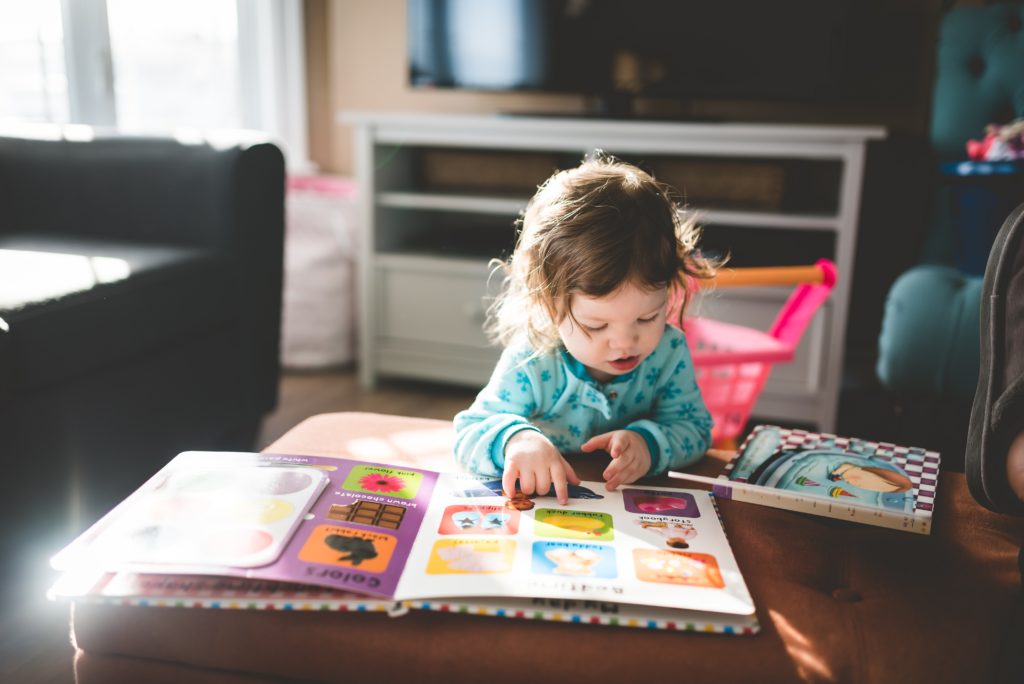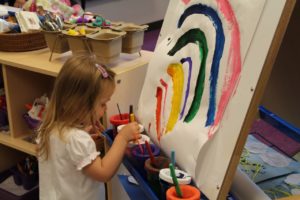Attempting to teach preschool in your own home may sound like a bit of a nightmare at first. I mean, if we’re being realistic, kids can be quite the daily handful. And that’s without adding letters and numbers into the mix.
The good news is, you don’t have to worry about strict lesson plans, pop-quizzes, or investing in expensive brain-measuring equipment to track progress. Preschool should simply be about exploring, laughing, and having fun. In fact, in our home we call it “play-school” because that’s really what every day feels like when we do it right. Playtime, with the extra bonus of learning!
How To Teach Preschool Subjects
Even so, it can be beneficial to know a bit about how to teach preschool before you get started. These tips are just a few things that I have found helpful in teaching the different areas of preschool curriculum. Some of these ideas are borrowed from my elementary education classes and some are from experience with my own children. (You can learn a lot watching your kids learn!)
The one other thing that I would like to stress here at the beginning is that, if at any time the child is getting bored, frustrated, or distracted, go on to something else or out to the sandbox. Don’t make these activities seem like work, because if it isn’t fun, it won’t be learning.
Here are some helpful teaching tips I’ve found while “playschooling” each of these subjects over the years with my kids.
Art
Teaching art gives your child the opportunity to practice their fine motor skills, express creativity, and build self-confidence. Here are some tips I learned about how to teach preschool art.

Tips To Help Teach Preschool Art
1. Accept and praise everything reasonable. If they are trying, encourage them, never criticize. Find something good about that three-headed cow who is eating what looks like a small car, even if you were trying to create a completely different preschool craft.
2. Don’t fix their art. Allow them to color their horses green, give their stick figures giant fingernails and glue hats on upside-down. The point is that it is their own work, not yours. You already know what color to make horses, how to draw a perfect stick figure and which way the hat should go. And when it comes right down to it, isn’t it boring to do it perfectly all the time?
3. But remember, there is a difference between teaching a concept (gluing, cutting, painting, etc.) and correcting their mistakes. If children feel criticized, they will not be as anxious to try again.
4. When you look at a big scribble on the page and find yourself wondering what it could be, instead of saying “What is that?” with an extremely puzzled look on your face, say, “Tell me about your picture”. And do your best to find the positive points on the page.
5. Expose them to several different artists. Some fun ones to study are Jackson Pollock, Vincent van Gogh, M.C. Escher, and Andy Worhol. After you look at several of their works, try your hand at using their medium (oil, watercolor, clay) and producing art in their style. If you are really ambitious, this is a good place to study different aspects of art, such as line, color, shading, etc. You can also add in interesting little tidbits about each artist’s life.
Science
Science teaches kids to ask questions, make predictions, observe, and then communicate and make sense of what they see. This process can help kids grow in their curiosity, and learn about the world around them in the most organic way possible.

Tips To Help Teach Preschool Science
6. Begin by teaching the scientific method in its simplest form:
- Hypothesize – What do you think will happen?
- Experiment – Let’s try it and find out.
- Compare hypothesis with results – What happened?
- Give conclusions – Why?
For example, we want to find out what kinds of objects a magnet will attract. First, we discuss what we think will happen when we put each object close to the magnet. Then we try it out making sure to compare our hypothesis with what actually happened. Finally, we try to find out why the magnet attracted certain objects by looking closely at what the objects had in common.
7. Find out together. It is important that children understand that adults do not know ALL the answers, unless you do. It is even more important that children understand that it is usually possible to find the answer. If you come to a scientific concept that you don’t understand; don’t just give your best guess and leave it at that. Be brave and tell them you don’t know. Then, with them by your side, look until you find the answer (or until you need to take a break for food).
9. Research! Find an encyclopedia, check the dictionary, get books from the library, browse the internet, ask someone who you think might know, etc. Exhaust all possible resources for an answer and let the children help you find out. You will be giving them one of the most invaluable tools, if you will teach them to search for the answers to their questions. It is a big part of learning and life.
10. Let them figure it out and explain it to you. I have heard some of the most fascinating (and humorous) explanations to simple scientific questions when I wait to teach until after I have given my children a chance to give their “hypothesis”. My 5-year-old told me one day that objects float because “invisible people are holding them up or something”. Now that I never knew. Besides being thoroughly entertained as a parent, it is a wonderful experience for children to feel that their opinion is valued. And finally, allowing them to figure it out teaches them to think for themselves and not always rely on you for the answers.
Make-believe
You might be wondering why I include make-believe in my preschool curriculum. I’ve found that taking time for make-believe gives kids the chance to explore the world from a different perspective. It strengthens their understanding of others, their problem-solving abilities, and their imagination.
Besides that, it’s just fun! I love presenting my kids with all kinds of adventures that they might not otherwise have in “real life”. Here are some tips about how to teach pretend.

Tips for Teaching Make-believe
11. Let them be in charge if they will. When using make-believe as a learning activity, give the children the tools, costumes, props, and the scenario and then let them take off with it. Most children are much more proficient at pretending than adults are. They are in their element, let them be the boss.
12. Listen and learn. Here is a perfect opportunity for you to take a glimpse into your child’s mind. Often when my children are pretending, I find out what they are thinking. And occasionally when someone is the mother, I find out what they think about me. Sit back and enjoy listening to your children. Watching them pretend is one of the most entertaining pastimes you’ll find.
Language Arts
One of my very favorite subjects! Reading to your kids is another great way to expand their understanding of the world. And learning to read and write can help them develop language and listening skills.

Tips To Help Teach Preschool Language Arts
13. Even after children learn to read by themselves, it’s still important for you to read aloud together. By reading stories that are on their interest level, but beyond their reading level, you can stretch young readers’ understanding and motivate them to improve their skills.
14. By consistently reading to your child every day, your child will learn to concentrate and sit still for longer periods of time, which can help later on when they go to school.
15. Reading to your children leads to questions about the book and the information within. It gives you a chance to speak about what is happening and use this as a learning experience. It may also develop an interest in different cultures or languages.
16. Be animated. Read each book to its fullest potential. Your voice and facial expressions give a book life. Make it an exciting one.
17. Let them fill in the blanks. If a book repeats phrases or words, has pictures that help you discover some of the words, or if the child has read a book several times and knows it well, pause when you come to an obvious word and let them say it. This is a big part of teaching children to read. When they read their favorite books over and over again until they can ‘read’ it without your help, they begin to believe that they have the ability to read. And they do in a sense. What better way to encourage reading than to help them learn to ‘read’ the books they love? Actual reading will come in time, but this is a great beginning for any child!
18. Talk about the story. Stop at “cliff-hanger” pages and ask them what they think will come next. Talk about how the characters feel or why they are acting a certain way. Use books to discuss your own opinions on topics like anger, selfishness, greed, laziness, being polite, kindness, etc. For example, those first two pigs are kind of lazy aren’t they? What happened to them because of it? Or, Cinderella’s stepmother wasn’t very kind, was she? And so on.
19. Share your favorites. Find your favorite authors and illustrators and buy or check out their books frequently. Make sure to mention how you love Mark Buehner’s artwork or the way Dr. Seuss uses words. Talk to them about what they like or don’t like in different books.
Music
Music is an amazing learning tool. It catches children’s attention, helps with memory retention, and provides another fun outlet for creativity. Don’t forget to dance!

Tips To Help Teach Preschool Music
20. Change the words. This is a simple concept, but not always easy to do. When we learned about kayaks, we changed the words of “Row Your Boat” to “row your kayak” and we rowed down a “river” instead of a “stream”, etc. One of my children’s favorite songs is “Goodnight Ladies”, only they’ve never actually heard it sung the right way. I sing, “I love Rachel, cutie cutie Rachel, I love Rachel, I’ll love her all my life.” They think they each have their own song. Make up your own individualized songs. They don’t have to be perfect, just entertaining.
21. Do actions or act out the story in the song. Use stick puppets for the animals in “Old MacDonald” or let the children be the frogs in “5 Little Speckled Frogs”. Make a giant spider and a tiny one to use for “Eensy Weensy Spider”.
22. Have fun with music. Most children love to sing and they don’t usually care if you can’t carry a tune in a bucket. Just let them know you are having fun. Listen to all kinds of music: classical, country, jazz, marching band, individual instruments, Gregorian chants. If nothing else, it will broaden your horizons.
23. Use repetition. If you are trying to teach a new song to your children, don’t expect them to sing it after they have heard it only once. Find fun actions for them to do while you repeat it several times or have them listen for a certain word in the song each time you sing it. After they have heard it 6 or 7 times, they will have it in their head and will most likely be able to sing it back to you. Sometimes more often than you would have chosen. But most of all, have fun!
Physical Activity
In order for a child to be productive for any amount of time, they must move. If you do not provide movement activities for them, they will provide their own. As you probably know if you have spent any amount of time trying to keep your child sitting still in church. But physical activity isn’t just for that short attention span, it’s also a great form of exercise!

Tips To Help Teach Preschool Physical Activity
24. Include walks, park visits and field trips. Anytime you go on a walk, to a park, or on a field trip as a preschool activity, give the children a purpose. Have them look for everything that is green or have them find circles or squares. Ask them to see if they can find out what each animal eats at the zoo or the animal farm, or have them see if they can go on the swings, teeter-totter, slide, and monkey bars 3 times each.
Having a purpose does not mean that anything else they stop to look at is a distraction. Maybe when you see that they are picking up every rock or touching every bug, you will want to change your focus. Don’t criticize them for being children. Allow them some room, but having a purpose gives a little more meaning to your outings.
25. Find lots of different ways to move. You thought you could only move like a person? How would you move if you were spaghetti? If you were a glacier, how would you melt? How would you blow yourself up if you were a balloon? Let the children choose ways to move. Follow them. Teach them different kinds of dance: ballet, jitterbug, tap, modern. I think that most children love to dance and believe that they can, until someone laughs at them or criticizes them. Never, NEVER let that someone be you. It will come too soon as it is.
Food
There’s no better way to get kids’ attention than with food! You can both teach kids about food and use it as motivation or a break between some of the other activities. Plus, if you’re going to be eating at least three times a day anyway, why not use this time to get in a little extra learning?

Tips for Teaching Food
26. Conduct taste tests. This is so fun! Find all the different kinds of apples or cereal or bread that you can and try each one while blindfolded. We did this with apples one day and my son will never let me go to the grocery store without requesting “his” apples. He knows that he loves Granny Smith apples the best because he tried them all! It is part of who he is.
27. Have fun and creative snacks. There are a hundred ways to make a sandwich: in triangles, shapes, triple-deckers, strange combinations, different kinds of bread, etc. Keep and use a file of fun ways to make kids’ snacks.
28. Fix a “letter of the week” dinner. If you are wondering what to fix for dinner or if you are feeling ambitious, find a recipe that begins with the letter that week: spaghetti for “S” week, enchiladas for “E” week, etc.
Math
Teaching your preschoolers numbers and math helps them to think logically and practice problem-solving skills. It also provides them with yet another way to see and explain what’s going on in the world around them. Numbers, shapes, and math are everywhere!

Tips To Help Teach Preschool Math
29. There are lots of great counting books like the M&M’s Counting Book and Ten Black Dots. Take one chubby little finger in your hand and point and count each figure. The repetition becomes ingrained until they are counting without knowing how. It’s especially adorable to hear, “One, Two, Fee, Four, Five, Sits, Sits, Ten!” or some variation. Record it. You won’t regret it.
30. Measuring cups and spoons are a part of every kindergarten math curriculum, but instead of a worksheet, get a bucket of water and some towels and figure out how many teaspoons fill a tablespoon and how many cups fill a pint jar and all the other possibilities. Kids do not tire of this easily. And after you’ve played with the math of it for a while, you can take a breather while they spoon and scoop until the only water left is in their soaked shirt and the towels.
31. If you have a thrift store nearby, keep an eye out for little stuffed ducks or frogs. Once you have five of each, you can sing “Five Little Speckled Frogs” or “Five Little Ducks” and have the little ones hold the animals. As each duck disappears in the song, have the child hide it behind them or have them give it to you. The more animated you are with these songs, adding awesome quacks and glugs and wide eyes, the more times they will want to repeat them. Don’t know why this is so fascinating, but it is.
32. One-to-one correspondence is something that comes with development, so at first when you count Cheerios or toes, they will inevitably come up with a number either off the charts or they’ll get stuck at two. Don’t worry. Just guide their tiny fingers and count slowly touching each object one at a time as you say the number. They’ll pick it up.
33. I love combining math with “finish your dinner.” The old “I’m done, Mom” in our house was always followed by, “How old are you?” and then, “Okay, take that many bites.” It’s not heavy math; we’re definitely not at calculus level, but every little bit, right?
34. Making little number books out of objects can be a fun way to connect the numeral with the number of objects it represents. Staple together a book with twenty blank pages and help them draw the number on one side and glue flat objects on the other side. You can do this with buttons or stickers or construction paper shapes or anything that will stick. You could also do two of each on the 2 page for hours more of counting fun. Don’t be surprised or disappointed if you only get to page three. Remember the attention span in minutes is less than the number of years old a child is. Until you get to ten and then it stays pretty static. Except for video games. Don’t ask me why.
Preschool Time Is Playtime
Whew! That’s a whole lot of tips to remember while chasing your preschoolers around the house. But in all honesty, I can probably boil them down to one simple, golden rule: if it isn’t fun, it isn’t learning. So get out there, armed with crayons, snacks, books, and nursery rhymes, and just play the day away with your preschoolers.
Have you used any of these teaching tips for your at-home preschool? Or do you have any other tips you would add to this list? Let us know in the comments!
Looking for more activity ideas?
We’ve got something for every letter of the alphabet! Over 800 activity ideas, all organized by letter for easy preschool lesson planning. That includes ideas for snacks, books, music, field trips, crafts, and so much more!



